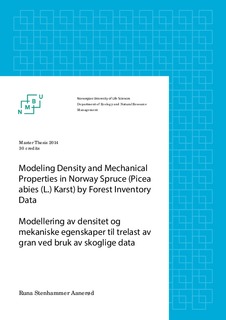| dc.description.abstract | The properties of Norwegian timber varies greatly, but no quality sorting is done before the logs are sawn to boards at the sawmills. This means that large amounts of timber with wide variation in quality pass through the grading system, resulting in a smaller yield in the higher strength classes.
The requirements for structural timber are getting higher due to stricter safety margins in new standards. Still, forest owners are only rewarded by the volume the timber contains, and not based upon the strength of the timber. Thus, forest owners don't focus on which strength classes the timber belongs to during harvesting which causes a grading loss in higher strength classes.
To meet the requirements from producers and customers, a more correct description of the timber is of importance. To achieve this, an earlier sorting and a more precise prediction of the wood properties is necessary. In this study, the timber properties are predicted by forest inventory data to investigate the potential of presorting by the use of variable at site, tree and log level.
Density, modulus of elasticity (MOE) and modulus of rupture (MOR) were measured on 1206 boards from 205 Norway spruce (Picea abies (L.) Karst.) trees, sampled from 14 sites in south-eastern Norway. The variability of the properties was analyzed in linear mixed models where the random variance was divided into site variance, tree variance and residual variance. Variables at stand level, tree level, log level and board level were treated as fixed effects, and added as covariates to the model.
For density, relative log height in tree (Hrel), expressed as the ratio of the position of one log to the total tree height, was the most important fixed effect, and density increased with increasing relative log height. For MOE, both the H/D-ratio, defined as the ratio of tree height to DBH of each selected tree, DBH and the interaction between Hrel and DBH were important fixed effects. MOE increased with increasing H/D-ratio and interaction between Hrel and DBH, while it decreased with increasing DBH. For MOR, DBH was the most important fixed effect, and MOR decreased with increasing DBH.
Variance due to site accounts for a smaller proportion of the total variance in MOE and MOR than in density, while the within-tree variance accounts for a larger proportion of the variance in MOE and MOR than in density. Density is better explained than MOE and MOR at stand level, while this difference is much smaller, and partly opposite when also tree and log variables are included. This is probably because the density varies quite a lot at stand level, while MOE and MOR are also influenced by knots and other defects which may vary between trees and within trees. Since the strength properties are explained differently on stand, tree and log level, this means that the potential for sorting at different levels are not equal for density, MOE and MOR.
For density, variables at stand, tree and log level reduced the site and tree variance to a greater extent than IP-value from Dynagrade. For MOE and MOR, variables at stand, tree and log level alone did not reduce the site and tree variance to a greater extent than IP-value, but the contribution from these variables improved the grading in combination with Dynagrade.
Presorting using forest inventory data has the potential of improving the grading yield, but an implementation in the forest industry will require great effort and a desire from the entire value chain to be feasible. | nb_NO |

